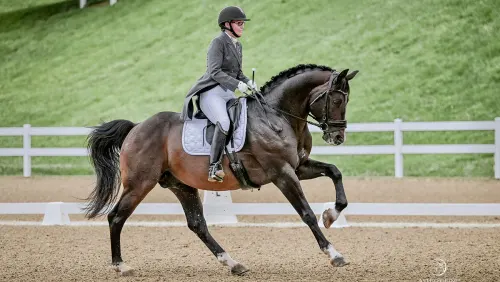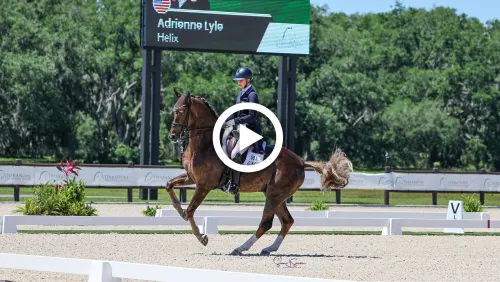West Palm Beach, Fla.—Feb. 16
You didn’t have to be a Grand Prix rider to come away from Day 2 of the Global Dressage Forum North America with plenty of knowledge and a few new exercises to try.
And whether it was a seasoned Grand Prix horse, one new to the level, or one below the FEI-levels, the same emphasis on basics carried throughout the day.
“We learn riding by riding, not by talking,” said German trainer Conrad Schumacher in his session on classical riding. “That is for me absolutely clear. As a dressage trainer, you have to have an imagination—how the rider rides and what the rider needs.”
And with that, he began by sectioning off the bottom third of the ring with poles and having Jaralyn Finn perform simple trot-walk transitions approaching each corner to show how he teaches young Grand Prix riders.
Once that was established, he had Finn try it from canter to walk in the corner, then pick up canter and give with the reins. “When the half halts go through properly, we can then demonstrate an uberstreichen, hands go to the front and back again. The neck of the horse must stay where it is,” he said. “For a competitor, it’s extremely important to have a horse when it comes to the corner, comes back on it’s own. The horse must not run through a corner. We teach that in the very beginning.”
Schumacher emphasized allowing the horse to stretch down and had riders performing uberstreichen at regular intervals to reward their horses and test self-carriage.
Schumacher reminded the audience, many of whom were dressage trainers themselves, that they must be positive when teaching their students new things. “Don’t be picky as a trainer,” he said. “Be generous. When you are too picky and you criticize everything all the time, the riders stop riding. We can do amazing things when we have fun. One of our most important tasks is the keep them happy, but serious happy.”
Schumacher had riders demonstrate several of his favorite exercises, but noted they were not systematic, just different working patterns he likes to use when necessary.
Shoulder-in on the centerline, alternating directions of shoulder-in on the long side, canter poles on a circle and medium canter to shoulder-fore to halt on the long side provided enough gymnastic effort to benefit any horse.
British judge Stephen Clarke offered his insights on the foundations of dressage to finish out the day. “The horse and the rider must both be happy,” he said, reiterating yesterday’s theme. “There must be harmony. I’m totally against anything that’s done forcefully.
“You’ve heard it all already, but for me dressage is about reaction,” he said as Louisa Marcelle Eadie warmed up in the ring with Baltazar. “In the other disciplines, if the horse is behind your leg, coming into a cross-country fence or a show jump, you could break your neck. To me, there are three areas if you are to train a horse to a high level. It’s got to begin with reaction. A horse has to be in front of a rider’s leg, in a good rhythm and balance and to work without any limit through a suppled frame. The other area is that every horse is loose, supple and submissive in the bend.”
Clarke noted he sees too many riders overriding when they don’t get a reaction from their horse—sitting, pushing and shoving against a backward contact, resulting in limited paces and an incorrect frame.
ADVERTISEMENT
“I don’t think you should keep a horse breathing fire for the entire time,” he explained. “I think it’s very important to be able to switch a horse on and switch a horse off. I think to switch a horse on is equally important for mental and physical health.”
Throughout the session Clarke emphasized basic exercises to test the horse and rider. “I very much try to tell riders that there should always be an individual shoulder-in sensation. It’s the preparation for virtually all of the exercises,” he said.
In discussing rider position he said, “riders should think outside aids are ‘guarding aids.’ The outside leg guards the quarters, the outside rein guards the shoulder. The inside aids should be more activating, suppling aids.”
After performing shoulder-in, Baltazar created the reaction Clarke was aiming for by stretching well into the bridle on a circle and willingly lengthening and shortening his frame in trot and canter. Eadie went on to perform several steps of passage and flying changes with ease. “I want to know there are no limits either to the submission of the back or the reaction to being in front of the leg,” Clarke said. “That there’s no blocks in the frame. If there were any blockages in the frame, when she comes to ride him up to the bridle, all she do is hot those blocks and create a stiff horse. We want a supple horse that can really use himself.”
Tidbits
– Terry Ciotti Gallo of Klassic Kur gave a presentation about putting together a musical freestyle.
“I look for harmony first,” she said. “If the rider is struggling with the horse, you don’t get to see what they’re presenting to you.”
She used a metronome to calculate the beats per minute of the horse Betsy Steiner rode. Then she played a selection of music from an instrumental version of Beyonce’s “Single Ladies” to a more classical piece trying to find good music to match the horse’s rhythm and tempo.
“Know what [movements] you must do, what you may do and what you’re forbidden to do,” she advised. “Consider the point of view of the judge at C when thinking about the placement of your movements. Sometimes people get a little too clever. If they don’t have a good shoulder in, they do it on the short side at A. Really? Is the judge going to see that? Think like the judge. Make sure the lines are very clear. Sometimes lower level riders wander around the arena, like a fly in a paper bag. The use of A-symmetry is fine.”
“I think you come a little out of your normal training and introduce things that are not normal for [your horse] in the test, but might be normal in your training,” Steiner added. “Try abstract things that might be unique for that horse.”
– Swedish Olympian Tinne Vilhelmson-Silfven showed off one of her up and coming mounts, the 10-year-old Hanoverian stallion Benetton Dream FRH and her recent CDI winner Divertimento in a demonstration of Grand Prix movements under the watchful eye of fellow Swedish trainer Bo Jena.
Divertimento is a hot horse, so Vilhelmson-Silfven made sure to be light with her aids, but make sure he was still in front of the leg in her warm up.
“It’s all about balance and communication so you don’t need such big aids,” she said. “The horses need to get all different kinds of work so they stay very focused and like to do their job. For Grand Prix horses, it’s more important to do gymnastic work to keep them relaxed and on my aids.”
ADVERTISEMENT
She started with transitions within the canter, seamlessly moving from five steps of a more collected canter to five steps of a lengthened canter, back and forth on a circle.
She moved on to quarter pirouettes on a square, and by the end of the session, was delighting the crowd with Divertimento’s powerful passage and piaffe.
“I think it’s important to let the horse decide which frame to work in, it’s very individual for every horse. It’s all about this elasticity, the going forward and coming back, that makes them self carry,” she noted.
Jena commented on Vilhelmson-Silfven’s rides and demonstrated long lining a horse.
The horse he used, 9-year-old Horatzio, was nervous, and Jena made sure to give with the inside rein several times before asking for piaffe.
“It’s a fantastic tool to have for all kinds of horses,” said Jena. “You have to make him a little bit proud. Pat him and be satisfied that he tries and is getting better and better. Don’t ask for more too early. [But the] same as in riding, the horse needs to take the information and have a reaction directly.”
– Susanne Von Dietze presented her views on the rider’s balance in movement. “I’ve been told I have a unique way of keeping it simple,” she said. “It really means that all of this complexity that movement contains needs to be put into a picture that makes sense. There is no rulebook to it. It would be so easy. Every horse is different and every rider is different.”
She described the aids, describing the shifting of the weight as a way to give a horse direction, and that the legs should whisper and breathe.
“I’ve heard a lot of times the riders say they like horses that are sensitive,” she said. “A hot horse needs the leg on and the lazy horse needs the leg off. Too strong of a leg kills the movement and stops the horse. Whispering with the legs means the rider allows the movement going through. There is a suppleness and elasticity from the hip to the angle. The breathing leg means the rider has the leg like a wet towel on the horse’s side. We need elasticity in the movement.”
– Stephen Clarke was awarded the GDFNA 2014 Lifetime Achievement Award.
– The GDFNA Aspiring Para-Dressage Rider Scholarship Award was given to Kelby Barranco, Boynton Beach, Fla., who was recently named the U.S. Dressage Federation’s Youth Volunteer of the Year.
Read all about happy horses in Day 1’s coverage.














